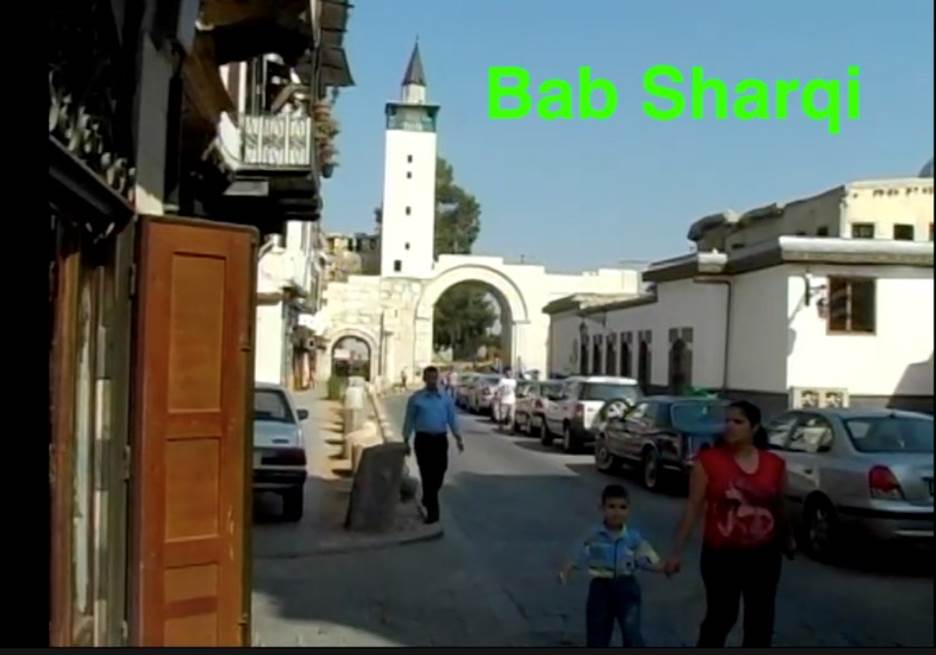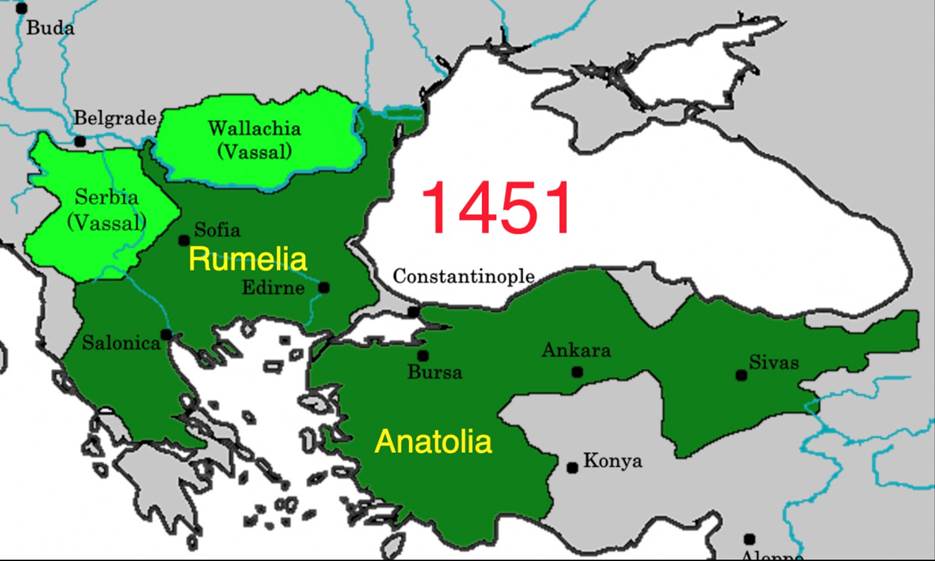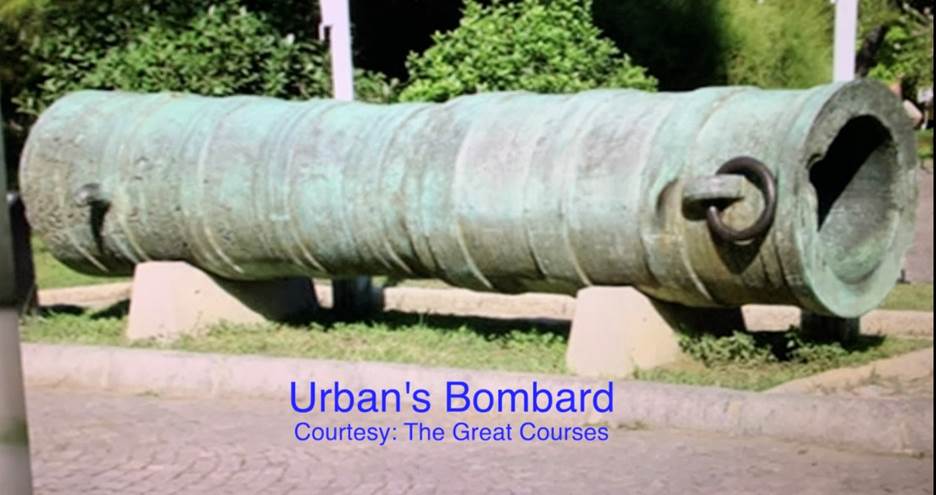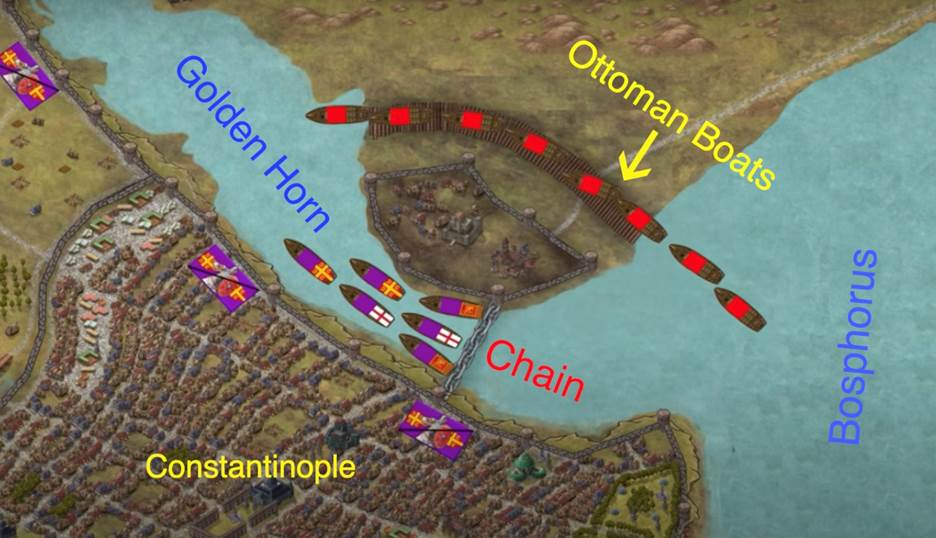
Byzantine Empire & Muslims: Two Historical Gates
By Khalid Siddiqui
Ohio
The western half of the Roman Empire collapsed in 476 AD, but the eastern half survived as the Eastern Roman Empire, or The Byzantine Empire, with its capital at Constantinople. Heraclius was its Emperor from 610 to 641.
The Muslims had their first encounter with the Byzantines in 629 AD. These skirmishes lingered on intermittently for another 824 years until they reached their final conclusion in 1453. Here is a short chronological account of this long conflict:
The Ghassanid tribe, a Christian community settled in Levant, was a client state of the Byzantines. In 629 AD, Prophet Mohammad sent an emissary to Ghassanids. The emissary was killed by the Ghassanids. The Prophet sent an army to punish the Ghassanids and the Byzantines. The Arab and Byzantine armies confronted each other at Mut’ah (present day Karak in Jordan). The Arab army lost its three commanders in succession. With great difficulty and courage Khalid ibn Walid was able to bring the rest of the force safely back to Medina. No property was exchanged in this battle. This Battle of Mut’ah was the first encounter of the Arabs with the Byzantines.
There were few more minor skirmishes between the Arabs and Byzantines in Syria over the next few years. A major battle (The Battle of Ajnadayn) was fought in Palestine between the Arab forces led by Khalid ibn Walid and Byzantines in 634 in which Southern Syria and Palestine were annexed by the Arab army.
The battle for the Byzantine province for Syria (Battle of Yarmuk) took place in August 636 near the River Yarmuk at the Syria-Jordan border southeast of the Sea of Galilee. The six-day battle resulted in comprehensive Arab victory that ended Byzantine rule in Syria. Emperor Heraclius collected holy relics and left Syria for Constantinople. Khalid ibn Walid entered Damascus on September 18, 636 through the Gate of the Sun, now called Bab Sharqi.
It is the only one of the eight gates of Damascus to have survived in the original form. It was built around 200 AD. The large central passageway was for wheeled traffic and the two smaller ones on the sides for pedestrians. The minaret was added by Sultan Nur ud-Din Zangi in the 12 th century. I walked through the gate in 2009 on foot just like Khalid ibn Walid had done on a horseback in 636. I hope the gate survived the recent civil war.
In the next few years, the whole of the Byzantine Levant (Syria, Jordan, Lebanon, Palestine and Southeast corner of Turkey) was in Arab hands. In 639, Amir Mu'awiya was appointed as governor of Syria, which included Levant.
In 639, an Arab Army under the command of Amr ibn al-As was sent to Egypt by Caliph Umar. The Arab Army defeated the Byzantine army at the Battle of Heliopolis. By 641, entire Egypt including Alexandria (the Byzantine capital of Egypt) was occupied by the Arabs. Byzantine Armenia also fell to the Arabs in 653.
The Byzantine Empire still controlled Anatolia (roughly present-day Asiatic Turkey), Thrace, Greece, and few islands in the Mediterranean Sea. The Byzantine Navy would frequently carry out raids against the new Arab population in the eastern Mediterranean. Mu'awiya obtained permission from the Caliph in Medina to build a fleet in the Mediterranean. The Muslim fleet was based in Alexandria. Sailors were mostly Yemenis. In 654, the Muslims defeated the Byzantine fleet in a series of actions. This stopped the Byzantine boats from raiding the Arab coastal cities. Byzantines were permanently driven out of Libya in 670 AD. Mu'awiya laid siege to Constantinople from 670 to 677 but couldn’t breach the fortified walls surrounding Constantinople. A later siege from 717-718 was repulsed by ‘Greek fire’ – an incendiary weapon used to set enemy ships on fire.
Since 640 AD, Arab had mounted expeditions into Anatolia almost every year until 740, and had besieged Constantinople on six different occasions. The Byzantines resisted and were able to drive off every incursion. Several of the Prophet’s companions took part in earlier raids. A cemetery believed to contain the remains of those martyrs is located outside Istanbul. In addition, three companions, Ayub Ansari, Abu Zar (Dharr) Ghaffari and Ka’b are buried in their own independent mausoleums. The tombs of the latter two are controversial. Abu Zar Ghaffari is supposed to be buried in Saudi Arabia! I have visited those three tombs in Turkey.
After 740 AD the Umayyad Caliphate was in decline. At that point the Arabs gave up permanently the dream of defeating the Byzantines in Anatolia and Constantinople.
Seljuks belonged to the military family of the Oguz Turkic tribes. They came from Central Asia (modern Turkmenistan). In the 11 th century they invaded eastern Anatolia (roughly present-day Asiatic Turkey). There they encountered the Byzantines. In the Battle of Manzikert in 1071 the Seljuks under Arp Arsalan defeated the Byzantines. The Seljuks gradually pushed the Byzantines further west and, eventually, controlled most of Anatolia forming the Great Seljuk Empire. However, in 1077 the western part of the Seljuk Empire seceded to form the Sultanate of Rum.
The Great Seljuk Empire collapsed in 1194. At that point, the Seljuk territory was incorporated into Khwarazmian Empire, a Persia-based empire that was eventually overrun by the Mongols in 1260s. Although the Sultanate of Rum managed to avoid the Mongols, it itself disintegrated into small principalities called emirates or Anatolian beyliks. Eventually one of these, the Ottoman, would rise to power and conquer the rest of the emirates. Thus, the Ottoman Empire was established in 1299 by Sultan Osman I. Sogut was its first capital.
His son, Orhan, further expanded the empire in Anatolia and moved the capital to Bursa. He later captured Gallipoli, a town on the European side of Dardanelles, giving Ottomans a strong bridgehead into mainland Europe. The two subsequent sultans, Murad I and Bayezid I conquered large areas in the Balkans and moved the capital to Edirne (Adrianople). The capture of Constantinople became a crucial objective as it was the direct route to Europe rather than through Dardanelles. Bayezid I laid siege to Constantinople in 1393 and 1395 but was unable, both the times, to break through its fortified walls.
Unfortunately, the Empire was invaded by Tamerlane (Taimur) from the east. At the Battle of Angola (Ankara) on July 20, 1402, he defeated the Ottoman army and captured Sultan Bayezid I, who died in captivity in 1403 by committing suicide. Tamerlane divided the Ottoman Empire into four vassal states, each one to be ruled by one of the four sons of Bayezid I. Tamerlane then left with the booty for China. For the next eleven years there was a civil war within the Ottoman Empire. That was the opportune time for the Emperor of Constantinople, Manuel II, to expel the Ottomans from Anatolia. But he couldn’t do it alone. He requested the Papal states of Central and Western Europe for help but they all refused. To them Orthodox Christians were as heretic as the Muslims. In 1413, Mehmed I, the 5 th Ottoman Sultan, was able to bring Anatolia and Rumelia under his control and reunite the Empire.
The Ottoman Navy under the sixth Sultan, Murad II, once again laid siege to Constantinople in 1422. However, its guns were not powerful enough to breach the fortifications.

When the seventh Sultan, Mehmed II, came to the throne in 1451, he was determined to capture Constantinople, but faced a legal issue. Prince Orhan Celebi was the second cousin and rival of Mehmed II. He had, somehow, escaped the traditional execution of the princes, and taken refuge in Constantinople. Any living price was always considered a threat to the sultan because he could always generate enough support to start a civil war. A deal was made between Mehmed II’s father, Murad II, and Emperor Constantine XI in 1449 whereby the emperor would keep the prince as a hostage in return for an annual tribute to be paid by Murad II. However, Constantine sent a message to Sultan Mehmed II in 1451 demanding more tribute, and hinted that unless more money was paid Orhan might be released, possibly sparking an Ottoman civil war.
Mehmed II took this demand by the emperor as a breach in terms of the truce, and it gave him a pretext to prepare for war. He expanded his navy and enlarged the army. He knew that the extant guns had not been able to touch the fortified walls. These double walls were built by Emperor Theodosius II in the 5 th century AD. Original Theosodian walls were severely damaged by the earthquakes of 437 and 447. Many sections and towers have been restored but some portions of the original walls and gates are still standing. (Watch the two short video footage.)
https://drive.google.com/file/d/1wquWBIIE6C0CY3Wm9n267veCKoXb2Wfx/view?usp=sharing
https://drive.google.com/file/d/1BgTZX3Zg0ax3YqVDZAXHo2ygQjZF9lnK/view?usp=sharing
Mehmed II hired a master gunsmith, Urban, from Hungary. He made the largest gun of the time called ‘Urban’s Bombard’. A section of it is on display in a museum somewhere in Europe. It could fire 600 to 700 pounds of stone for over a mile, but it could fire only 3-5 times a day.

Sensing the seriousness of Mehmed’s intentions, Emperor Constantine XI and his family converted publicly to Catholicism in order to get military support from western Europe. He then approached Pope Nicholas V for help. The Pope tried to get aid from the western countries, but to no avail. On their own, a few soldiers and sailors from Genoa, Naples and Venice came to his help. At the same time, Constantine attempted to appease the Sultan by sending him some gifts, but he responded by executing the emperor’s emissaries.
With all preparations completed, Sultan Mehmed’s army of 80,000 men laid siege to the city on April 2, 1453. Fearing a possible attack from the Ottoman Navy, the Byzantine Emperor had placed a strong chain fence across the entrance to the Golden Horn from the Bosphorus side. To bypass the chain barrier, the Sultan ordered the construction of a path of greased logs in the uninhabited northern side of the Golden Horn. He then had his ships dragged over the logs from Bosphorus to Golden Horn on April 22, 1453.
Then on April 23, 1453, Sultan Mehmed ordered a temporary bridge ‘Seferi Kopru’ to be built over the Golden Horn. Thousands of barrels, boats and barges were connected together using timber and steel hooks. It was covered by wooden flooring.

Bringing the Urban’s Bombard from Edirne to Constantinople required 200 men and 60 oxen. It was positioned against the Romanos Gate (Gate of Topkapi or Cannon Gate). After a siege lasting for two months, the final assault began on Tuesday May 29, 1453. The Bombard was successful in creating the breach in the walls. The fighting was over soon. Emperor Constantine died in the battle. Prince Orhan fought along with the Byzantines and tried to escape after the city fell but was caught and executed.
After the fall of Constantinople, Mehmed II entered the city through the Charisius Gate. The gate is quite dilapidated, and not open to the tourist groups. My guide was able to take me there. I passed through the gate on foot just like Mehmed II had passed through it on horseback in 1453.
Emperor Constantine's death marked the end of the Byzantine Empire. Thus, 824 years after the Muslims’ first encounter with the Byzantines, the dream of the Muslim armies was realized. Mehmed II proclaimed himself Caesar of Rome. He was only 21! Rumors spread that he had become Christian, which was not true. He stopped the looting and plundering in the city. Soon after, he moved the capital of the Empire from Edirne to Constantinople. Although Christians were allowed to practice their faith, they were relegated to the status of second class citizens. All the domed churches were converted into mosques. The smaller churches had to be walled off so as not to be visible from the street. Church bell ringing was banned. Public festivals associated with the Eastern Orthodox Church were disallowed. Christians were not allowed to bear arms. They couldn’t take service with the Sultan unless they converted to Islam and learned Turkish. However, there was no forced conversion. Their services were very much needed. They could speak many European languages and, therefore, were employed as interpreters by the government during negotiations with the European officials.
The fall of Constantinople sent shockwaves throughout Europe. As May 29, 1453 was a Tuesday under the old Julian calendar, the Greeks to this day don’t hold weddings on Tuesdays. So terrified were the European Monarchs of Mehmed II that when he died in 1481, there were celebrations throughout Europe.

